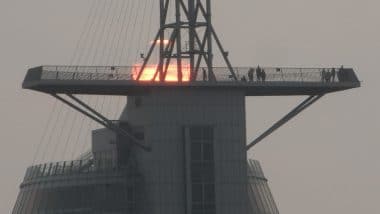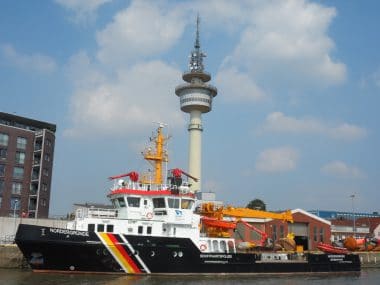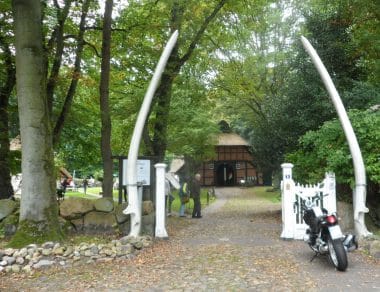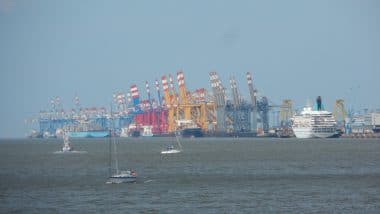Hamburg, Berlin and Bremen are Germany’s city-states. All of them are federal state and municipality at the same time, with Bremen having another special position: Bremerhaven, which is about 60 kilometres away and surrounded by the state of Lower Saxony, also belongs to the Hanseatic city on the Weser. The exclave has a good 117,000 inhabitants, making it the only major city on the German North Sea coast.
Strictly speaking, however, the North Sea only begins north of the city area, but this is hardly noticeable in view of the width that the Weser estuary has at Bremerhaven. The eye perceives it – in the truest sense of the word – as a flowing transition.
Bremerhaven – With a structural change from the past to the future

For a long time, the city, which is just under 200 years old and whose history is the focus of the Historical Museum on the banks of the Geeste, was a stronghold of fishing and shipbuilding. However, the cod wars in the 1970s and the shipyard crisis that began a little later forced the development of new economic mainstays:
Since then, favored by the settlement of the Alfred Wegener Institute and other institutions, there has been an increased focus on research, car handling, the offshore wind and food industry and, last but not least, tourism.
Over 450,800 hotel overnight stays were booked last year by visitors to Bremerhaven who spent an average of two days in the city. Raymond Kiesbye, Managing Director of Erlebnis Bremerhaven GmbH, puts the volume at “a total of more than 1.81 million guests”. On the other hand, the museums and tourist facilities of Seestadt were not able to enjoy a plus: their balance sheet closed with a slight minus.
Attractions in Bremerhaven’s city centre

The Emigration House, which was created with the development of the inner city area of Havenwelten, and the Climate House are still high in the favor of interest.
In the former, you can relive the stories of German emigrants who once set off for a new life in the USA by ship at Bremerhaven’s Columbus Quay. Since 2012, the multi-award-winning museum has also focused on immigration to Germany. Only a few steps away, the futuristic-looking Klimahaus opened in June 2009.
On a good 18,800 square meters, visitors can go on a virtual trip around the world along the 8th degree of eastern longitude to be confronted with climatic phenomena and the effects of climate change at the various stations.
Also just a stone’s throw away, the Zoo by the Sea and the Maritime Museum, two other and much more renowned attractions of the seaside city can be explored. However, less time can currently be allowed for the latter, because the main building, which was put into operation over 40 years ago, will be renovated and redesigned by 2021.
Until then, only the Kogge Hall as well as the outdoor area and the museum ships in the Old Harbour can be visited. Even older is the one opened in 1928 as an animal grotto, located at the foot of the Loschen lighthouse Zoo by the sea. Since its last renovation between 2000 and 2004, the facility has been completely redesigned, and the almost 300 mostly Nordic and aquatic animals – including polar bears, seals and penguins – are presented in attractive, near-natural enclosures.

A permanent fixture in the programme of every visitor to Bremerhaven is the Weser. With long benches and flood steps, it invites you to take a look at the ships. If you want to experience Bremerhaven and its surroundings from the air, you can take an elevator directly behind the dike to the 86-metre-high, all-round glazed viewing platform of the Sail City Hotel.
Another nine meters higher is a second platform, which is open to the wind and can be reached via a staircase. From here, the 114-metre radar tower also seems close enough to touch, with its weather-protected, barrier-free viewing platform at a height of 66 metres.
Thinking outside the box

There is a distance of a good 15 kilometres between Wulsdorf in the south and Weddewarden in the north of Bremerhaven. The topography really doesn’t make it easy for visitors to leave the relevant paths and explore districts outside the centre. But it is also worth getting to know sides of Bremerhaven that existed long before flourishing tourism in the city.
Thiele’s garden in the Leherheide district is one of these places: On about 20,000 square meters, the Thiele family of artists created a sculpture garden that is as impressive as it is bizarre, which has also been open to the public since 1990 and has made a name for itself as a cultural event venue. Lehe’s district of Speckenbüttel is also recommended for a detour: The park of the same name is one of the green lungs of the seaside city, and a visit to the open-air museum with its geest farm and marsh house can provide insights into rural life in past decades.

Further south, in the Geestemünde district, greenery also invites you to take a walk: Directly behind the main station is the entrance to the 64-hectare Bürgerpark with meadows and forests, the boat pond and landscaped gardens.
Here you will also encounter the oldest sculpture by Hein Mück, the Bremerhaven symbolic figure, who became famous from 1930 onwards through the hit song “Hein Mück aus Bremerhaven”, which was made popular not least by Lale Andersen, who was born in Bremerhaven-Lehe. Another attraction in the district is the weekly market on Konrad-Adenauer-Platz: Every Wednesday and Saturday morning, up to 70 traders offer their goods for sale at the largest market in the state of Bremen.
Fish and Ships

As befits a port city, thick pots can of course also be admired at close range in the fishing port: several times a day, the MS Dorsch departs for one-hour harbor tours . But the majority of people visit the fishing port because of its promenade with many quaint to chic fish restaurants and maritime shops.
If you need some food for your brain after eating and shopping, we recommend the Phänomenta experimental exhibition , whose secrets from science and technology amaze young and old.

The ships in the overseas port with the three basins of the Kaiserhafen, the Columbus quay and the container terminal are even larger. At over 4.5 kilometres, the latter is the longest river quay in the world. Superlatives – admittedly not in comparison with Hamburg and Rostock – the Columbus Cruise Center also contributes to Bremerhaven’s image: 111 cruise ship calls were registered here last year.
The best view of the fascinating hustle and bustle at the terminals, shipyards and locks is from the 15-metre-high container observation tower, but the closest you can get to the ships is on one of the one-hour harbour tours that start in the New Harbour. Alternatively, the HafenBus takes you right into the centre of the action.
Sail 2020

A major event, the likes of which only takes place every five years in Bremerhaven, awaits visitors to Seestadt 2020. More than 250 windjammers – led by the barque “Alexander von Humboldt II” – as well as large and small ships from over 20 nations will fill the ports at Sail 2020 from 19 to 23 August. More than 1.2 million guests did not want to miss the last edition of the festival days.
(Text + photos: Emma Sauer)


